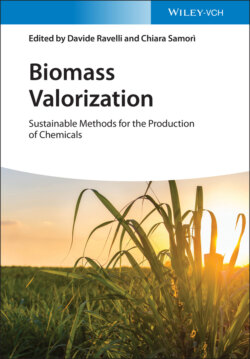Читать книгу Biomass Valorization - Группа авторов - Страница 26
2.4 Conclusions and Perspectives
ОглавлениеOngoing research toward the catalytic valorization of biomass is creating a foundation for sustainable chemical development. In numerous bench‐scale processes, acid catalysis has been shown to be a universal tool to source value‐added products from reactions of low value or waste cellulosic materials. The abundance of residual biomass derived from existing manufactories, such as in agriculture, algal aquaculture, forestry, and the food processing industry, can readily provide a sizeable amount of renewable substrates for the production of chemicals. Importantly, many products derived from such sources under acid‐catalyzed conditions, products such as low‐molecular‐weight carbohydrates, furaldehydes, functional acids and esters, phenols, and alkanes can be immediately employed in extant commercial settings. For example, cellulose‐derived alkyl (poly)glucosides can form a part of detergent formulas, alkyl levulinates and lignin‐based cycloalkanes can be used in the production of automotive fuels, and hydroxy acids can be polymerized into commodity polyesters. Nevertheless, most laboratory methods need substantial improvements before they may fully translate into commercial production. On the one hand, this translation requires further scientific research to render targeted catalytic reactions as efficient as possible. These studies will involve improved reaction conditions, separation processes, and, arguably most importantly, the development of catalysts capable of achieving highly selective processes involving transformations of biomacromolecules into known and new products. The designed systems must be robust and be easily recoverable for the next catalytic cycle. On the other hand, there remain technological difficulties. New technologies based on native substrates should optimally employ the whole biomass, not individual or refined components. Although this task may be partially solved by catalytic fractionation in lignocellulose refineries, as discussed in the chapter, the use of algal biomass remains less investigated. The separation and recovery of all valuable products in a given biomass, such as lipids, pigments, and proteins, necessarily enhances the value and sustainability of the approach and represents a significant opportunity to maximize value, but this approach embodies significant engineering, technological, and commercial barriers. For the foreseeable future, biorefineries are likely to focus on predictable and (essentially) uniform feedstocks with scale, such as lignocellulose or, possibly, algal biomass.
